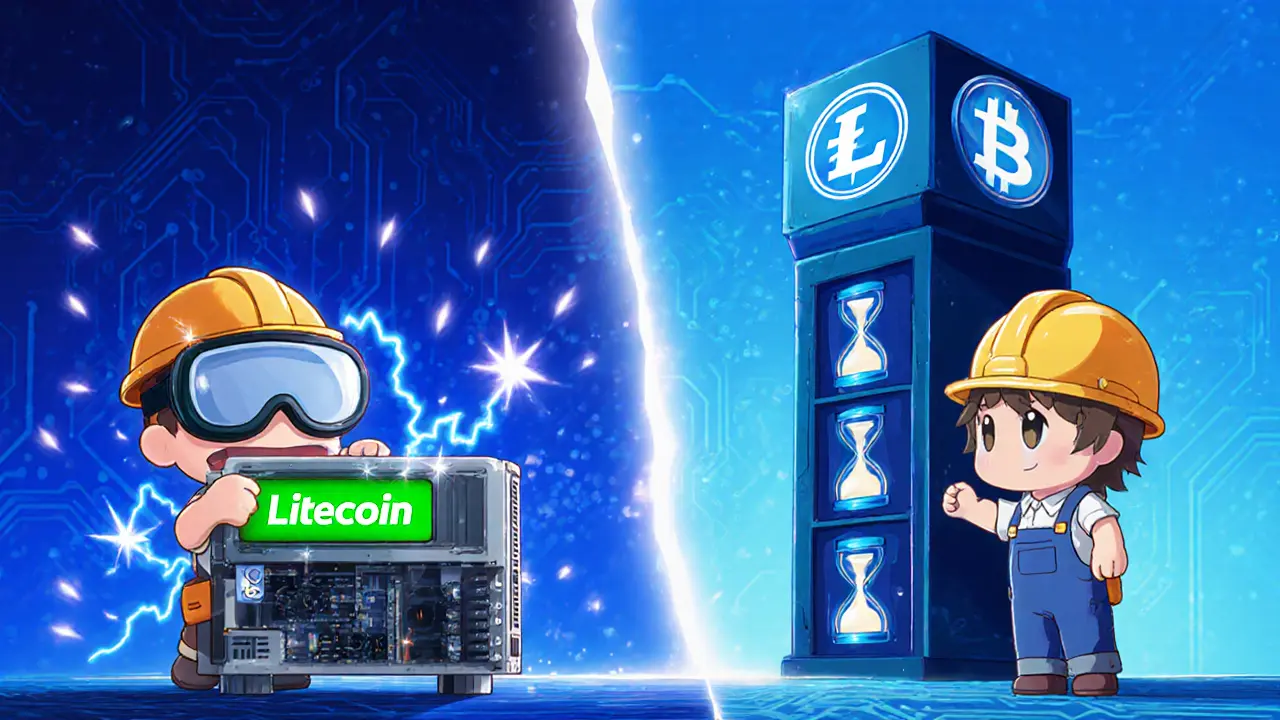Litecoin Halving Calculator
Mining Profitability Results
Ever wonder why a cryptocurrency suddenly spikes after months of quiet trading? The secret often lies in a built‑in event called a Litecoin halving. Every four years Litecoin trims the number of new coins entering the market by half, and that single tweak can ripple through mining profitability, price charts, and even the broader crypto ecosystem.
What Is a Halving?
In plain terms, a halving is a protocol‑level rule that cuts the block reward - the fresh coins a miner earns for confirming a block - by 50%. The rule is hard‑coded, so it triggers automatically after a set number of blocks, without any human decision. This creates a predictable supply schedule that mimics scarcity: fewer new coins mean a tighter supply, which can boost demand‑driven price pressure.
Litecoin’s Halving Schedule and Mechanics
Litecoin is a peer‑to‑peer digital currency launched in 2011. It uses a Scrypt algorithm for Proof‑of‑Work mining, which makes block times a speedy 2.5 minutes.
The first block reward started at 50 LTC. After 840,000 blocks - roughly every four years - the reward halves:
- 2015: 50→25 LTC
- 2019: 25→12.5 LTC
- 2023 (August 2): 12.5→6.25 LTC
Each halving marks about 1% of the eventual 84million‑coin cap being reached. The final Litecoin is expected to be mined around the year 2142.
Technical Contrast: Scrypt vs. SHA‑256
Bitcoin relies on the SHA‑256 hash function, which demands more raw computational power. In contrast, Scrypt is memory‑hard and historically allowed miners to use cheaper hardware like GPUs. This difference shapes the mining landscape: Litecoin’s faster block time and lighter algorithm make it more suitable for everyday payments, while Bitcoin’s heavier hash favors large‑scale ASIC farms.
Both networks schedule halvings, but Bitcoin does it every 210,000 blocks (≈4years) versus Litecoin’s 840,000 blocks. The timing aligns because Litecoin’s blocks are four times quicker.
How Halvings Impact Miners
When the reward drops, a miner’s income per hash falls instantly. If electricity and hardware costs stay the same, the profit margin shrinks. Smaller operators often find the new level untenable and either upgrade equipment or exit the network. The upside is that the hash power concentration tends to shift toward more committed participants, which can improve overall network security.
Most miners adapt by optimizing efficiency: using newer, more power‑efficient GPUs, joining mining pools for steadier payouts, or hedging rewards by selling a portion on the spot market while holding the rest.

Supply Shock Meets Market Sentiment: Price Effects
Historically, halving events have coincided with price rally phases, but correlation does not guarantee causation. A supply shock alone can’t lift prices if demand stays flat. Analysts from TokenMetrics point out a two‑fold impact: reduced inflow of new coins and heightened media attention, both of which can stoke buying pressure.
Conversely, BitPay warns that if broader market sentiment is bearish, a halving may simply accelerate a price decline because miners need to cover operating costs.
In practice, after Litecoin’s 2023 halving the price rose about 12% over the following three months, but the trajectory was also buoyed by a bullish crypto market and increased adoption of Lightning‑compatible wallets.
Litecoin vs. Bitcoin Halving: A Quick Comparison
| Feature | Litecoin | Bitcoin |
|---|---|---|
| Consensus algorithm | Scrypt | SHA‑256 |
| Block time | 2.5minutes | 10minutes |
| Halving interval (blocks) | 840,000 | 210,000 |
| Approx. calendar interval | ~4years | ~4years |
| Current block reward (2025) | 6.25LTC | 6.25BTC |
| Total max supply | 84million | 21million |
The faster block cadence gives Litecoin a natural edge for everyday transactions, while Bitcoin’s larger market cap creates deeper liquidity, which can smooth price swings after halving.
Preparing for the Next Litecoin Halving (≈2027)
Investors and miners alike can treat halvings as strategic milestones. Here are three practical steps:
- Analyze historical price patterns. Chart the 12‑month window before and after each previous halving to gauge typical volatility.
- Re‑evaluate mining economics. Use a profitability calculator that feeds in current LTC price, electricity cost (AU $0.12/kWh is a common benchmark in Perth), and hash‑rate. If margins dip below 10%, consider scaling up efficiency or shifting to pool mining.
- Adjust portfolio exposure. Some traders allocate a modest “halving fund” - typically 5‑10% of crypto holdings - to buy on dips and hold through the post‑halving rally.
Staying informed through community channels (Reddit’s r/Litecoin, Litecoin Talk forum) and analyst reports (SpectroCoin, TokenMetrics) helps you spot early signals.
Common Pitfalls and How to Avoid Them
- Expecting guaranteed price spikes. Halvings are supply events, not demand creators. Pair halving analysis with broader market research.
- Ignoring mining hardware depreciation. Older rigs lose efficiency faster after a halving, squeezing profit even more.
- Overlooking network hash‑rate trends. A sudden drop in hash‑rate can signal miner exit, potentially weakening security - a red flag for long‑term holders.
Broader Crypto Halving Landscape
Litecoin isn’t alone. Major coins like Bitcoin, Bitcoin Cash, and emerging PoW tokens (e.g., Zcash) also embed halvings. The collective effect shapes billions of dollars of market cap. Institutional traders now build “halving models” that factor in projected supply curves, on‑chain activity, and macro‑economic conditions.
Even though each coin has its own schedule, the underlying principle stays the same: controlled scarcity to protect value over the long haul.

Frequently Asked Questions
When will the next Litecoin halving happen?
Based on the 2.5‑minute block time, the next halving is projected for sometime in 2027, after roughly another 840,000 blocks are mined.
How does a halving affect my mining hardware?
The reward per block drops by half, so unless the market price rises enough to offset the loss, your revenue per kilowatt falls. Upgrading to more efficient GPUs or ASICs, or joining a mining pool, can help maintain profitability.
Will the halving cause Litecoin’s price to skyrocket?
Not guaranteed. Price moves when supply reduction meets steady or growing demand. If sentiment is bearish, a halving may have little effect or even a short‑term dip.
How does Litecoin’s Scrypt algorithm influence mining costs?
Scrypt is less power‑hungry than Bitcoin’s SHA‑256, allowing miners to use GPUs instead of specialized ASICs. This lowers entry barriers but also means competition is higher among smaller operators.
Is there a way to profit from halvings without mining?
Yes. Traders often set aside a portion of their portfolio to buy on dips before a halving and hold through the post‑halving rally. Some also use derivatives like futures or options to hedge against price volatility.







Chad Fraser
August 14, 2025 AT 22:51Hey folks!
If you're eyeing the upcoming Litecoin halving, think of it as a chance to reset expectations and maybe even boost community spirit.
The supply cut can tighten the market, but remember mining costs and hash‑rate adjustments play a big role.
Keep the conversation positive and share your calculations!
John Kinh
August 25, 2025 AT 10:51Another halving, another hype cycle 🙄.
Guess it's time to stare at the calculator again.
Mark Camden
September 4, 2025 AT 22:51From a macro‑economic perspective, the scheduled reduction in block rewards embodies a deliberate scarcity mechanism aimed at preserving intrinsic value.
Participants must recognize that such protocol‑level events are not mere marketing gimmicks but integral components of Litecoin's monetary policy.
The impending halving, slated for 2027, will halve the reward from 6.25 LTC to 3.125 LTC, thereby reducing the inflow of new coins by fifty percent.
Consequently, assuming demand remains constant, upward pressure on price is a logical outcome, though volatility should be expected.
Stakeholders are advised to adjust mining strategies accordingly.
Evie View
September 15, 2025 AT 10:51Enough with the polite optimism-this halving could crush small miners who are already operating on razor‑thin margins.
The electricity bills will stay the same while the reward slashes in half, and that reality bites hard.
If you think the price will magically skyrocket and save you, think again; the market is ruthless.
Many will be forced out, and the network hash‑rate could dip dramatically.
It’s a brutal wake‑up call for anyone still dreaming of easy profits.
Sidharth Praveen
September 25, 2025 AT 22:51Great breakdown!
Just adding that miners should also factor in the expected increase in transaction fees post‑halving, as they’ll become a larger portion of total revenue.
Staying ahead with efficient hardware can make the difference between profit and loss.
Nathan Blades
October 6, 2025 AT 10:51When we talk about Litecoin’s halving, we’re not just discussing a numeric reduction in block rewards, we’re confronting a pivotal moment in the cryptocurrency’s evolutionary narrative.
The very concept of scarcity has been the cornerstone of monetary theory since antiquity, and Litecoin embraces this principle within a digital frontier.
By cutting the reward from 6.25 LTC to 3.125 LTC, the protocol intentionally imposes a twenty‑five percent annual inflation rate, reshaping the incentive landscape for miners worldwide.
This shift compels a reassessment of operational efficiency, urging miners to scrutinize power consumption down to the joule per megahash.
Historically, such halvings have been followed by periods of heightened volatility, where speculative fervor meets fundamental demand.
Investors often experience a psychological surge, interpreting the reduced supply as a signal to accumulate, yet the market’s reaction is never guaranteed.
From a technical standpoint, the network’s difficulty adjustment algorithm will respond to fluctuating hash‑rates, potentially stabilizing block times but also influencing miner profitability.
Those equipped with modern ASICs or GPU rigs that boast favorable hash‑to‑watt ratios will find themselves better positioned to weather the contraction.
Conversely, older equipment may become obsolete, accelerating the turnover of mining hardware and reshaping the competitive hierarchy.
Energy costs remain a dominant factor; regions with subsidized electricity will see a relative advantage, while others may witness an exodus of miners seeking greener margins.
Moreover, the halving can indirectly affect transaction throughput, as miners might prioritize higher‑fee transactions to supplement their diminishing block reward.
This micro‑economic adjustment underscores the importance of dynamic fee markets within the broader ecosystem.
Strategically, participants should model multiple scenarios-optimistic price appreciation, stagnant demand, or even bearish pressure-to gauge the robustness of their operations.
Risk management, in this context, translates to diversifying mining pools, hedging exposure, and perhaps reallocating capital toward staking or other yield‑generating avenues.
Ultimately, the halving serves as a litmus test for Litecoin’s resilience, testing the community’s ability to adapt without compromising decentralization.
Whether you view it as an opportunity or a challenge, the upcoming 2027 event invites all stakeholders to engage with a renewed sense of purpose, aligning technology, economics, and collective ambition.
Somesh Nikam
October 16, 2025 AT 22:51Excellent deep‑dive! 😊 Your points about efficiency and scenario planning really hit home.
Mining profitability calculators become essential tools here.
Jan B.
October 27, 2025 AT 10:51Agreed its a solid guide for miners
MARLIN RIVERA
November 6, 2025 AT 22:51The optimism is misplaced; most small‑scale miners will see their margins evaporate after the halving, making the whole hype a distraction from hard economics.
Debby Haime
November 17, 2025 AT 10:51While the numbers look tough, remember that innovation often thrives under pressure; many miners has already started upgrading gear to stay ahead.